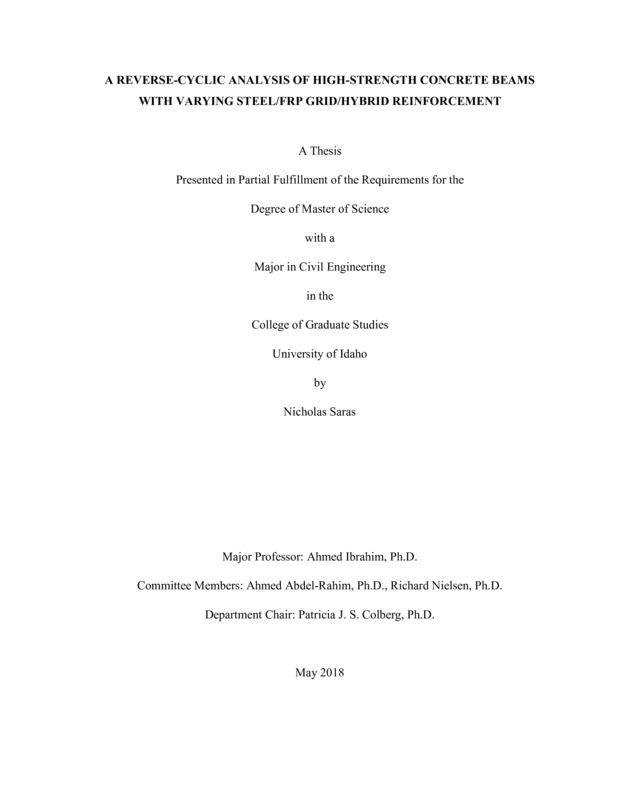A reverse-cyclic analysis of high strength concrete beams with varying steel/FRP grid/hybrid reinforcement
Saras, Nicholas R. (2018-05). A reverse-cyclic analysis of high strength concrete beams with varying steel/FRP grid/hybrid reinforcement. Theses and Dissertations Collection, University of Idaho Library Digital Collections. https://www.lib.uidaho.edu/digital/etd/items/saras_idaho_0089n_11332.html
- Title:
- A reverse-cyclic analysis of high strength concrete beams with varying steel/FRP grid/hybrid reinforcement
- Author:
- Saras, Nicholas R
- Date:
- 2018-05
- Keywords:
- carbon fiber fiber reinforced polymer glass fiber High strength concrete hydraulic actuator reverse-cyclic analysis
- Program:
- Civil Engineering
- Subject Category:
- Civil engineering; Materials Science
- Abstract:
-
The main goal of this study is to investigate the behavior of high strength concrete beams with varying steel, FRP, and hybrid reinforcement under reverse-cyclic loading protocol. For this experimental program, five high strength concrete beams were prepared and cast using a concrete with compressive strength of 10 ksi. All beams produced were 7 feet long, 9 inches in depth and 8 inches wide. The control beam was reinforced with traditional Grade 60 #5 steel bars and others were reinforced with carbon fiber and glass fiber grids. Additionally, the last two beams were reinforced with steel and FRP. All beams used 2#3 Grade 60 steel rebar for top reinforcement and as stirrups, spaced at 8 inches. The beams were fixed on both ends and subjected to a three-point displacement controlled reverse-cyclic loading. The data collected in this study included the following: load-displacement (mid-span), strain in FRP grids, steel rebar, stirrups, and concrete, mode of failure and crack spacing and thickness.
The study concluded that the behavior of the HSC beams was primarily dependent on the tensile strength and modulus of elasticity of each type of reinforcement. Experimental calculations showed a decrease in moment capacity for the FRP only reinforced beams. The hybrid reinforced sections showed an increase in moment capacity. The mechanistic model values using code ACI 318 and 60% of the given FRP tensile strength as provided in ACI 440R were in good agreement with the experimental results. For the hybrid reinforced beams, moment capacities calculated using ACI 440R was proven to be over-estimated. Although ACI 440R designs for externally wrapped FRP, the sectional analysis was performed the same way. The yield and ultimate deflection calculations using ACI 318 and 60% tensile strength were proven to be under-estimated. However, followed the same pattern from beam to beam (Beam 1 was the smallest deflection and Beam 3 was the largest). Thus, the ductility index model was proven to be under-estimated as well, which suggests the need to modify the existing deflection calculations when high strength concrete is reinforced with FRP grids. The hybrid reinforced beams were proven to have an increase in the ductility capacity.
- Description:
- masters, M.Engr., Civil Engineering -- University of Idaho - College of Graduate Studies, 2018-05
- Major Professor:
- Ibrahim, Ahmed
- Committee:
- Nielsen, Richard; Abdel-Rahim, Ahmed
- Defense Date:
- 2018-05
- Identifier:
- Saras_idaho_0089N_11332
- Type:
- Text
- Format Original:
- Format:
- application/pdf
- Rights:
- In Copyright - Educational Use Permitted. For more information, please contact University of Idaho Library Special Collections and Archives Department at libspec@uidaho.edu.
- Standardized Rights:
- http://rightsstatements.org/vocab/InC-EDU/1.0/

